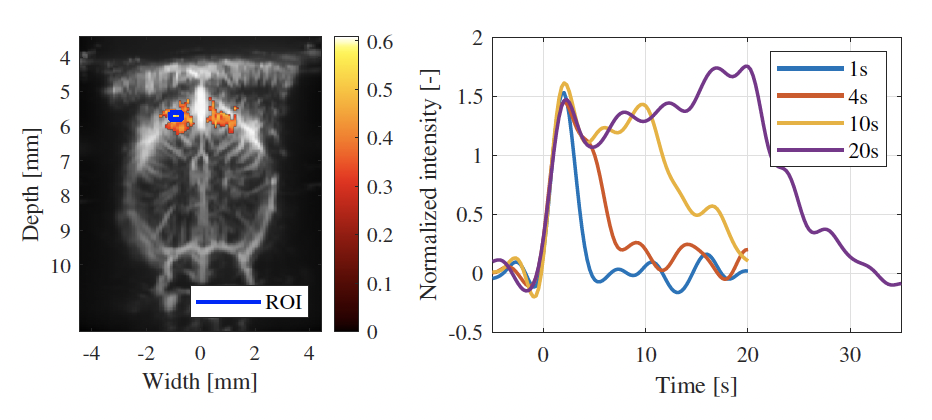MSc thesis project proposal
Nonlinear identification of the hemodynamic response in functional ultrasound
Functional ultrasound (fUS) is an emerging neuroimaging technique that provides high sensitivity images of cerebral blood volume changes. These changes reflect neuronal activity in the corresponding brain area, since increased metabolic demands of active tissue induce variations in local blood volume and flow. The main advantage of this technique is that it can image the entire brain with great spatial (50-500um) and temporal resolution (10-100ms), which opens new horizons in understanding healthy brain function, as well as serious neurological disorders, such as epilepsy.
The fundamental challenge is that fUS only provides an indirect measure of brain activity through the neurovascular coupling (NVC), which is the link between the local neuronal activity (system input) and the resulting blood flow changes (system output). The majority of studies addressing the NVC assume a linear time-invariant (LTI) system model, which can be described by an impulse response known as the hemodynamic response function (HRF). However, under certain circumstances, deviations from the behavior of an LTI system can become too severe to neglect, examples of which include experiments with closely repeated stimuli, or under changing duration or strength of stimuli. The goal of this thesis is to investigate the nonlinear characteristics of the HRF and their dependence on the stimulus.
Assignment
Recent work in our group has shown the suitability of second-order Volterra series to model subject responses to long visual stimuli. Volterra series are high order extensions of the Taylor series: e.g. a first-order Volterra series simply describes a one-dimensional convolution operation, whereas second-order kernels describe pairwise interactions of the input signal at different time instances.
The thesis work will start with a literature review to understand functional ultrasound imaging technology and existing methods for HRF modelling and identification. Afterwards, fUS measurements on mice will be used to answer (a subset of) the following questions:
1. Under which stimulus conditions (e.g. length, intensity) can the fUS measurements be better approximated using a nonlinear HRF, as opposed to a linear one?
2. Are kernels of order > 2 more suitable to model interactions of long visual stimuli samples than second-order kernels? How well do these kernels predicting individual responses when trained on different stimulus durations?
3. Which HRF identification methods result in meaningful HRF shapes, when the system input signal (stimulus) is known?
4. Are there brain regions where the fUS measurements can be better fitted and predicted using other signals related to the stimulus (e.g. time derivative) as the input to the nonlinear hemodynamic system?
5. How can the Volterra kernels be jointly estimated with the input signal?
It is possible for the student to define and investigate further research questions, in collaboration with the supervising team.
Requirements
We are looking for a student from electrical engineering, systems and control or biomedical engineering with a strong signal processing background. Good programming skills (in Matlab, Python or Julia …) are also required. Previous experience with biomedical signals is appreciated.
Contact
dr. Borbála Hunyadi
Signal Processing Systems Group
Department of Microelectronics
Last modified: 2023-08-08
